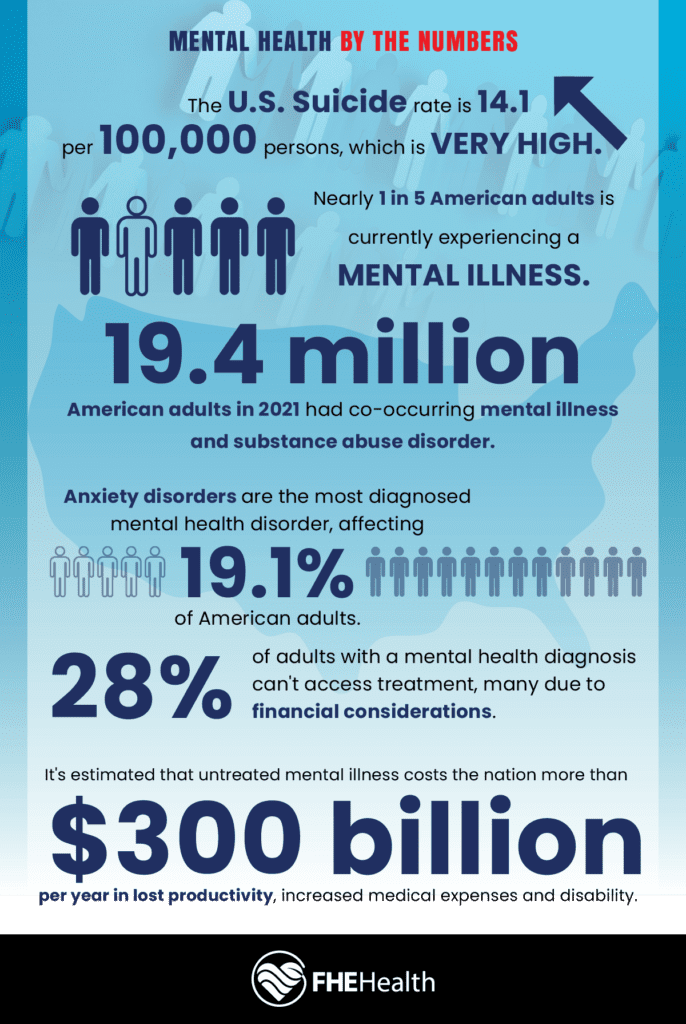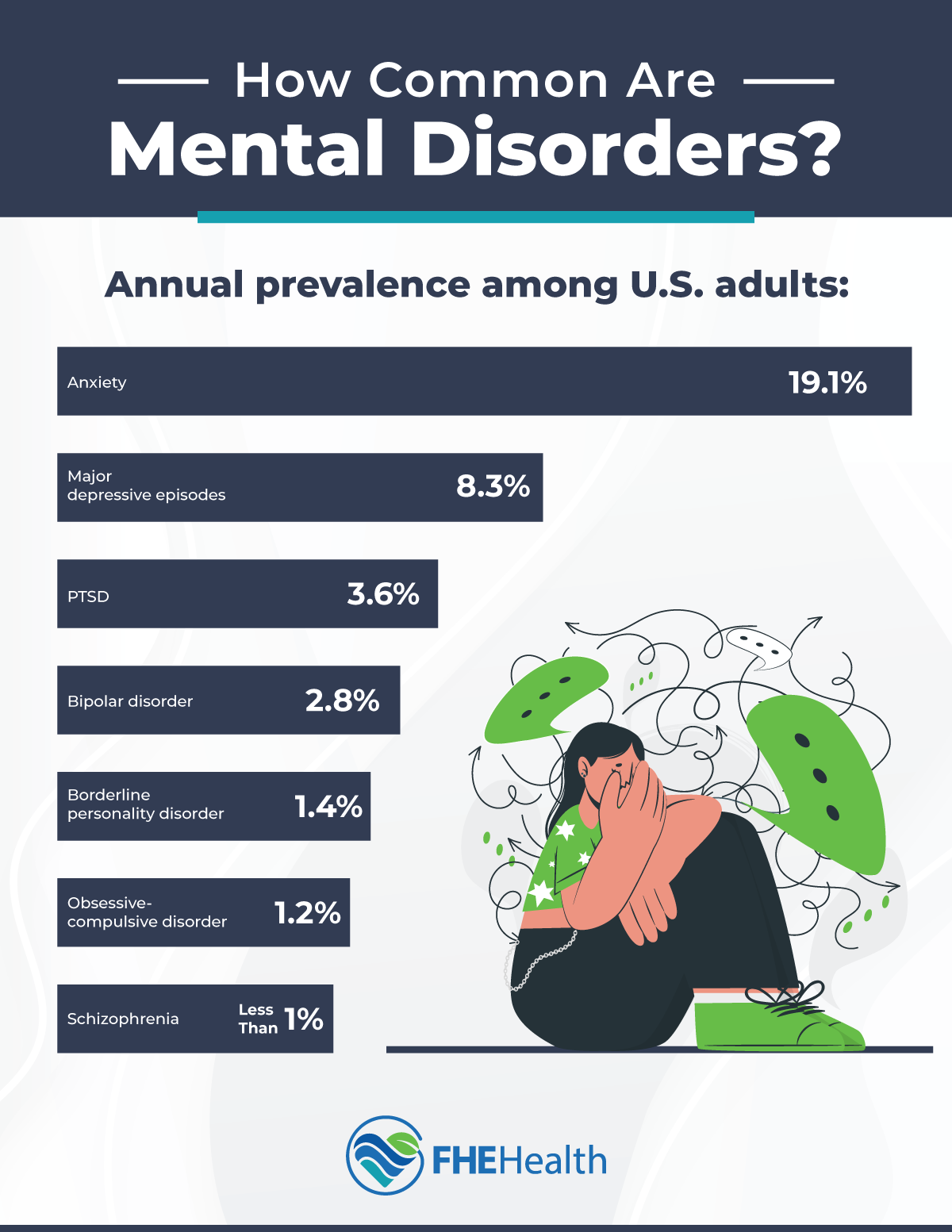Mental health statistics show that more than half of all Americans will have a mental health diagnosis at some point in their lives, with 1 in 5 experiencing mental illness in any given year (6). Dive into the statistics on mental health conditions and some of the most common diagnoses.
Mental Health Statistics Worldwide
- Nearly 1 billion people worldwide have a diagnosed mental illness, and rates of anxiety and depression have increased since 2019. (1)
- More than 700,000 people die every year from suicide. (2)
- Suicide is the fourth leading cause of death among people aged 15-29. (2)
- 1 in 7 adolescents aged 10-19 experiences a mental health issue. (3)
Countries Compared to the United States
- Nearly a quarter of American adults report having a mental health diagnosis, which is higher than the rates in 10 other high-income countries. (4)
- The U.S. suicide rate is very high at 14.1 per 100,000 persons, which is the 9th highest worldwide. (5)
- In 2021, a higher percentage of females in the United States (27.2%) than men (18.1%) reported having a mental illness. Females are also more likely to have a severe mental illness (7%) compared to their male counterparts (3%). (22)
Disorder-Specific Mental Health Statistics
The latest adult mental health stats revealed:
- Nearly 23% of American adults experienced a mental illness in the past year. (6)
- 1 in 6 American young adults aged 6-17 reports having a mental health disorder each year. (20)
- Approximately 50% of all lifetime mental health conditions first appear by the age of 14, with 75% occurring by age 24. (20)
- 19.4 million American adults in 2021 had co-occurring mental illness and substance abuse disorder. (20)
Let’s take a look at the statistics for some of the most commonly diagnosed mental illnesses.
Depression
While most people will experience depression at some point in their lives, it’s likely not at the level of a mental illness. To get a diagnosis of major depressive disorder, it must be chronic and debilitating.
- Depression is estimated to affect 3.8% of the population globally, including 5% of adults and 5.7% of those aged 60+. (7)
- In the United States, there are approximately 48,000 suicide deaths each year. (8)
- As many as 8.4% of U.S. adults have a major depressive episode each year, which is nearly 21 million people. (8)
- Suicide is the second-leading cause of death in the United States for youth aged 10-14. (20)
- Major depression is one of the most common conditions in the United States. (21)
- Nearly 5% of American adults report having suicidal thoughts. (21)
Anxiety
According to available mental health statistics, anxiety disorders are the most commonly occurring. They span a wide range of diagnoses, including generalized anxiety disorder (GAD), panic disorder, social anxiety disorder (SAD), obsessive-compulsive disorder and specific phobias.
- Anxiety disorders are the most diagnosed mental health disorder, affecting 19.1% of American adults. (9)
- GAD affects 5.7% of adults in the United States at some point. (10)
- SAD is the most common and one of the most debilitating anxiety disorder diagnoses, affecting 7.1% of the population. (9)
- Panic disorder affects 2.7% of Americans. (11)
Bipolar
Bipolar disorder, also referred to as manic-depressive disorder, is characterized by periods of mania and depression. Severe expressions of this disease can include hallucinations, difficulty concentrating, loss of appetite, fatigue, suicidal thoughts and various other symptoms.
- 4.4% of U.S. adults are estimated to receive a bipolar diagnosis at some point in their lifetime. (12)
- Diagnosis is most likely to occur between the ages of 18-29. (12)
- Bipolar disorder is one of the most debilitating mood disorders, with 82.9% of those diagnosed showing severe impairment. (12)
Schizophrenia
Schizophrenia is a mental illness that falls into the psychotic category of disorders and is often seen as a co-occurring diagnosis with other mental health disorders. Those with the disorder are substantially more likely to die younger, often due to physical health issues masked or misdiagnosed due to schizophrenia.
- Only 0.25% to 0.64% of people are expected to develop schizophrenia, making it a very rare diagnosis. (13)
- While rare, it’s among the most debilitating mental illnesses, hitting the top 15 reasons for disability worldwide. (13)
Eating Disorders
Eating disorders affect both under- and overweight individuals who may have binge-eating disorder, anorexia nervosa, bulimia or other types of disordered eating.
- 28.8 million Americans will develop an eating disorder at some point during their lifetime. (14)
- Approximately 1 out of 5 people who develop anorexia nervosa attempt suicide. (15)
- Genetic heritability plays a major role in the development of eating disorders. (15)
Mental Illness Statistics on Treatment
All the mental illnesses discussed here have treatment options available, many of them highly successful. Unfortunately, access to mental health care is often out of reach, even after a person receives a diagnosis. Limited access to care and private insurance plans that don’t include mental health coverage contribute to the problem.
- Most adults with a mental illness don’t receive treatment, totaling 28 million Americans. (16)
- In South Carolina, nearly 80% of youth patients with depression receive no treatment. (16)
- 28% of adults with a mental health diagnosis can’t access treatment, many due to financial considerations. (16)
- There’s only 1 mental health professional per 350 people in the general population. (16)
- In 2021, less than half (47.2%) of Americans with a mental illness received treatment for their condition. (20)
- The average delay between the initial onset of symptoms from a mental health condition and seeking treatment is 11 years. (20)
- Almost 1 in 4 Americans with a mental health condition report they try to get treatment but can’t. (21)
- More females in the United States (51.7%) than men (40%) receive treatment for a mental health illness. (22)
Health Care Costs and Lost Productivity Due to Mental Illness
Leaving those struggling with mental health issues without access to care can be devastating for the individual and their family and costly to society at large.
- It’s estimated that untreated mental illness costs the nation more than $300 billion per year in lost productivity, increased medical expenses and disability. (17)
- The economic cost of eating disorders alone is estimated at nearly $65 billion each year. (14)
- Post-pandemic, the economic cost of untreated mental illness is expected to reach $1.6 trillion. (17)
- Untreated mental illness is the reason for approximately 15% of all emergency room visits annually, which represented $11.4 billion in unnecessary spending in 2017 alone. (18) (19)
- Depression and anxiety conditions are estimated to cost the global economy $1 trillion in productivity each year. (20)
If you think you may need help to address a mental health condition, contact us today. At FHE Health, our compassionate and competent mental health providers won’t let you become another statistic.
References
- WHO – Mental Disorders fact sheet https://www.who.int/news-room/fact-sheets/detail/mental-disorders.
- WHO – Suicide fact sheet https://www.who.int/news-room/fact-sheets/detail/suicide.
- WHO – Adolescent Mental Health fact sheet https://www.who.int/news-room/fact-sheets/detail/adolescent-mental-health.
- NIH – Mental health conditions and substance use comparisons https://collections.nlm.nih.gov/catalog/nlm:nlmuid-101769552-pdf.
- OECO – Health status – Suicide rates https://data.oecd.org/healthstat/suicide-rates.htm.
- MHA – Adult ranking data 2022 https://mhanational.org/position-statements/the-state-of-mental-health-in-america/.
- WHO – Depression fact sheet https://www.who.int/news-room/fact-sheets/detail/depression.
- CDC – FastStats – Depression https://www.cdc.gov/nchs/fastats/depression.htm.
- ADAA – Anxiety Disorders – Facts & Statistics https://adaa.org/understanding-anxiety/facts-statistics.
- NIMH – Generalized Anxiety Disorder https://www.nimh.nih.gov/health/statistics/generalized-anxiety-disorder.
- NIMH – Panic Disorder https://www.nimh.nih.gov/health/statistics/panic-disorder.
- NIMH – Bipolar Disorder https://www.nimh.nih.gov/health/statistics/bipolar-disorder.
- NIMH – Schizophrenia https://www.nimh.nih.gov/health/statistics/schizophrenia.
- Harvard School of Public Health – Report: Economic Costs of Eating Disorders https://www.hsph.harvard.edu/striped/report-economic-costs-of-eating-disorders/.
- JAMA – Mortality Rates in Patients With Anorexia Nervosa and Other Eating Disorders: A Meta-analysis of 36 Studies https://jamanetwork.com/journals/jamapsychiatry/fullarticle/1107207
- MHA – The State of Mental Health in America https://mhanational.org/issues/state-mental-health-america.
- Commonwealth Fund – Mental Health Care Needs in the U.S. and 10 Other High-Income Countries https://www.commonwealthfund.org/publications/surveys/2021/oct/mental-health-care-needs-us-10-other-high-income-countries-survey.
- HCCI – Ouch!: New Data reveals ER spending increased by 51% from 2012–2019, with patient out-of-pocket payments increasing by 85% https://healthcostinstitute.org/emergency-room/ouch-new-data-reveals-er-spending-increased-by-52-from-2012-2019-with-patient-out-of-pocket-payments-increasing-by-88.
- Mental Health By the Numbers
https://www.nami.org/about-mental-illness/mental-health-by-the-numbers/ - Quick Facts and Statistics About Mental Health
https://mhanational.org/mentalhealthfacts - Mental Illness
https://www.nimh.nih.gov/health/statistics/mental-illness










